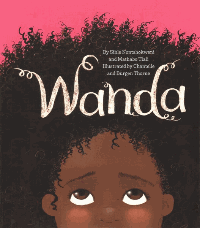Wanda
 Wanda
Wanda
Picture Book / South Africa
Crocodile Books
2021
32

Eight-year-old Wanda is unhappy due to the endless mocking of her hair by the boys at school, but when Makhulu (grandmother) shares her grooming secrets and stories of beautiful women with locks just like Wanda, she realizes her hair is a crown and is something to be proud of.
Written by South Africans and originally published in South Africa in four local languages, this brightly illustrated picture book includes Zulu words sprinkled throughout the text. The South African setting may not be obvious to U.S. children but the issue the authors are addressing will be, i.e. bias against natural black hair. Misconceptions about what black hair is, or should be, are perplexing to many people living in cultures heavily influenced by white standards of beauty. Deviations from the norm of long straight, or curled hair tend to draw negative remarks.
The protagonist is Wanda, an eight-year-old black girl who lives in a middle-class neighborhood and attends a multicultural school. The exact ethnicity of most of the students is unclear because they are rendered in silhouette and often in the background. Two male schoolmates, Thula and Sizwe, are clearly black. Several children are clearly white and one girl with long dark hair appears South Asian.
Wanda is upset by comments about her “bushy hair” from Thula and Sizwe. Her teacher Mrs. Stone (English name but ethnicity unclear) also expresses disapproval. She suggests that Wanda tame her hair with a headband from the “lost property box.” Wanda herself disapproves of her hair, “No one else seems to struggle like me,…My hair is made of thorns.” Since we do not see any schoolgirls pictured as black in the illustrations, it would appear that Wanda is struggling with the disapproval of her hair texture and style alone. She does admire the cool, coiffed young black women she has seen strolling along Mlungiseleli Drive.
Wanda’s mother and Makhulu (grandmother) heartily approve of Wanda’s bushy hair and help her resolve her “problem.” They call her a queen and describe her hair as “her crown.” They show her a scrapbook of famous, beautiful, internationally acclaimed black women with the various textures of hair wearing different styles. They also show her photos of themselves as young women with bushy Afros. Only then does Wanda realize that black girl beauty is possible and that she inherited her strong hair from both her mom and grandma. Grandma uses an olive oil emollient and water to soften Wanda’s hair and allows her to choose her preferred hairstyle for school. With her new natural hairstyle, Wanda walks tall, full of confidence. When Thula and Sizwe see the new Wanda with cornrows and beads holding back her springy hair, they are stunned and call her a “queen.”
The storytelling here is encumbered by a tad too many plot lines and other than the scrapbook, there are no surprises in the story. Still the much-needed reinforcement of black beauty is welcome. The book conveys a message that encourages black girls to accept their hair and wear it naturally, regardless of the texture. Pair Wanda with Lupita Nyongo’s Sulwe, another celebration of black girl beauty.
Reviewed by Fatima Barnes, EDD, MPH, MSIS, MBA, Howard University, Louis Stokes Health Sciences Library
Published in Africa Access Review (October 7, 2021)
